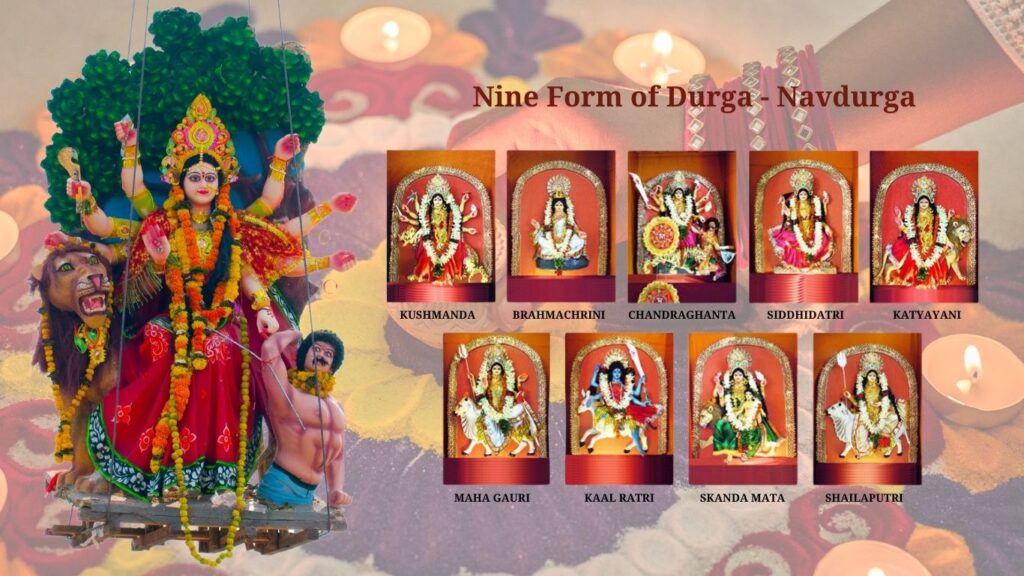
Mata Shailaputri – The Daughter of the Mountains
Mata Shailputri is the first among the nine forms of Goddess Durga, collectively known as Navadurga, and is worshipped on the first day of Navratri. Her name, “Shailputri,” means the “Daughter of the Mountain,” as she was born as the daughter of the Himalayan King in this incarnation. In her previous birth, she was Sati, the daughter of King Daksha and the wife of Lord Shiva.
Mythological Background
In her previous birth as Sati, the daughter of Daksha, she was deeply devoted to Lord Shiva. However, her father, Daksha, disapproved of her marriage to Shiva and once held a grand Yagna (sacrificial ceremony), deliberately excluding Lord Shiva from the event. Despite her father’s refusal, Sati attended the Yagna, where her husband was insulted. Unable to bear the humiliation of Lord Shiva, Sati immolated herself in the sacrificial fire. In her next birth, she was reborn as Parvati, the daughter of the Himalayas, also known as Hemavati. Once again, she became the consort of Lord Shiva, fulfilling her eternal bond with him.
As per the Upanishads, Mata Shailputri is regarded as the embodiment of Shakti, the divine energy from which even the most powerful deities like Brahma, Vishnu, and Shiva draw their strength. After being humbled by her might, the gods, including Indra, offered their prayers and acknowledged her as the source of all power.
Symbolism and Iconography
Shailputri symbolizes strength, devotion, and purity. Her mount is a bull, which is why she is also referred to as Vrisharudha (one who rides the bull). She holds a Trishul (trident) in her right hand, symbolizing power and protection, and a lotus flower in her left hand, representing purity and spiritual awakening.
Her influence extends to cosmic forces as well. The Moon, known as the provider of fortunes, is believed to be governed by Goddess Shailputri. Worshipping her can help overcome the malefic effects of the Moon, according to astrological beliefs.
Rituals and Worship
On the first day of Navratri, devotees worship Mata Shailputri with great devotion. It is believed that she resides in the Muladhara Chakra, which is the root chakra of our spiritual energy system, representing the foundation of life and the basis of stability. Offerings of Jasmine flowers, her favorite, are made during puja to please the Goddess.
Devotees chant her mantras, prarthana, and stotra with deep reverence, invoking her blessings for strength, prosperity, and the removal of obstacles.
Mantra:
ॐ देवी शैलपुत्र्यै नमः॥
Om Devi Shailaputryai Namah॥
Prarthana:
वन्दे वाञ्छितलाभाय चन्द्रार्धकृतशेखराम्।
वृषारूढां शूलधरां शैलपुत्रीं यशस्विनीम्॥
Vande Vanchhitalabhaya Chandrardhakritashekharam,
Vrisharudham Shuladharam Shailaputrim Yashasvinim.
Spiritual Significance
Mata Shailputri is the personification of devotion, purity, and strength. By worshipping her, devotees aim to purify their minds and bodies, while seeking the strength to overcome the challenges in their lives. Her blessing ensures stability in life and the removal of emotional and physical imbalances.
The Shailputri Stuti reflects her protective nature:
या देवी सर्वभूतेषु माँ शैलपुत्री रूपेण संस्थिता।
नमस्तस्यै नमस्तस्यै नमस्तस्यै नमो नमः॥
Ya Devi Sarvabhuteshu Maa Shailaputri Rupena Samsthita,
Namastasyai Namastasyai Namastasyai Namo Namah.
Shailputri Kavacha (Protection Armor)
Devotees also recite the Kavacha to invoke the protective power of the Goddess:
ॐकारः में शिरः पातु मूलाधार निवासिनी।
हींकारः पातु ललाटे बीजरूपा महेश्वरी॥
Omkarah Mein Shirah Patu Muladhara Nivasini,
Himkarah Patu Lalate Bijarupa Maheshwari.
Conclusion
Mata Shailputri, the embodiment of divine power and strength, inspires her devotees to rise above worldly attachments and stay committed to the path of righteousness. Worshipping her on the first day of Navratri opens the door to spiritual growth and leads to a deeper connection with one’s inner self.
